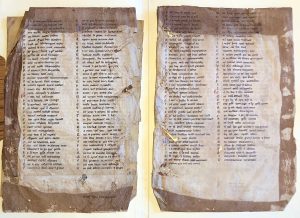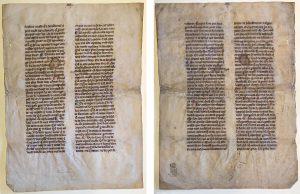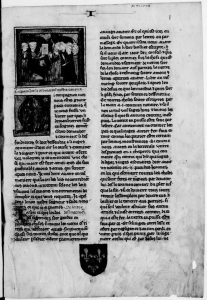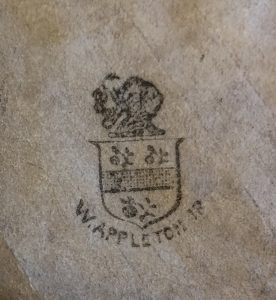Laura Ingallinella, Mellon Postdoctoral Fellow in Italian Studies & English, Wellesley College and Agnieszka Rec, Associate Editor, Publications, MHS
In her essay collection Ex Libris, Anne Fadiman suggests that every library contains an “Odd Shelf.” “On this shelf,” she writes, “rests a small, mysterious corpus of volumes whose subject matter is completely unrelated to the rest of the library, yet which, upon closer inspection reveals a good deal about its owner.”[i] While Fadiman’s own odd shelf holds books on polar exploration, the Massachusetts Historical Society’s arguably contains works of a noticeably older vintage.
Among the MHS’s hundreds and thousands of linear feet of family papers, rare books, and scholarly volumes are some two dozen medieval manuscript books and fragments, covering a range of topics from Spanish history to urine to the quest for the Holy Grail. [ii]

One particularly intriguing example is an unidentified medieval manuscript leaf in the Appleton Family Papers. Today, we’re happy to say: mystery solved! The fragment is in fact a late thirteenth-century excerpt of a text on procedural law, specifically the French translation of the Ordo judicarius by Tancred of Bologna (c. 1185–c. 1236).

Born in Bologna and educated at the university there, Tancred was one of the leading authorities on ecclesiastical law in his day.[iii] After studying with renowned jurists Azo, John of Wales, and Lawrence of Spain, he taught canon law at his alma mater and often advised popes on legal and diplomatic matters. During his busy career as a teacher, writer, diplomat, consultant, and man of God, Tancred wrote many procedural texts, which he compiled into a complete manual, the Ordo judicarius, between 1214 and 1216.[iv]
The Ordo quickly became a standard reference manual for canon law and circulated widely over the centuries—it exists today in over a hundred manuscripts—and was also translated into French, German, and Portuguese.[v] The French translation, titled Li Ordinaires mestre Tancrés or more simply Ordinaire, was dedicated to a “noble Philip, king of France,” either Philip III (1270–85) or Philip IV (1285–1314). It seems to be a remarkably good translation: Frédéric Duval has noted that the translator tried his level best to turn Tancred’s dull and often repetitive legalese into a more lively vernacular text that could appeal to a “larger public” of law practitioners.[vi]
With the identification of the MHS fragment, the Ordinaire survives in ten manuscripts, five of which date before 1300.[vii] The script is a refined late thirteenth-century Gothic script (the so-called littera textualis) of better quality than other manuscripts of the Ordinaire produced in the same period (see, for example, Metz, Bibliothèque municipale, MS 1196). The page layout (or mise-en-page) of the manuscript, with two columns and paragraph marks in red and blue, resembles those of the earliest copies of the Ordinaire.
Like its Latin source, the Ordinaire is divided into four books, which deal, respectively, with judges; defendants and other parties; legal procedure; and sentencing. The MHS fragment is from book 3, chapter 13. That chapter discusses the so-called instrumenta, that is, the written evidence produced by the various parties involved in a trial. In an premodern age of handwritten documents, how could a judge trust that a piece of evidence was authentic? What were the telltale signs that an important document, such as a contract or a will, had been tampered with or even forged? Reading this fragment, we glimpse a legal system concerned with perjury, falsification, and ill intent, as well as a dogged pursuit of the “truth”—issues very relevant today.
So far our previously unidentified manuscript has a title, author, and approximate date, but what can we say about where it comes from? To answer that question, we turn to the language of the fragment. In this case, as with many manuscripts produced in France over the thirteenth and early fourteenth centuries, we can more conclusively say where it does not come from. We can exclude areas such as northern, northeastern, and southwestern France (namely, Picardy and Artois, Lorraine, and Gascony). The “neutral” spellings, word forms, and syntax found in this fragment normally suggest a provenance from the Île-de-France, that is, the environs of Paris, a major center of book production.[viii] Other important manuscripts of the Ordinaire (for example, Paris, Bibliothèque nationale de France, MS fr. 1073) were also produced there.[ix] It is also worth remembering that the Ordinaire had been written for the king of France, and Île-de-France would have been the first hub where a Parisian-born translation would circulate.

One final question remains: What is this medieval European manuscript doing among the MHS’s very American collections? This particular witness of Tancred’s Ordinaire entered the collections in 1864 as a gift from a W. Appleton Jr., likely William Joseph Warren Appleton (1825–1877), son of Rep. William Appleton (1786–1862). A library stamp is found in the lower left corner on one side of the leaf bears the name “W. Appleton Jr.” Seemingly something of a manuscript collector, William J. W. Appleton also donated several other manuscripts to the New England Historic Genealogical Society the same year as his donation to MHS.[x]

In our next post, we’ll delve further into the MHS’s premodern Odd Shelf and see what closer inspection might reveal about the historical society.
[i] Anne Fadiman, “My Odd Shelf,” Ex Libris, New York: Farrar, Straus, and Giroux, 1998, 21.
[ii] The De Ricci-Bond census lists twenty-seven, but there may well be more among the MHS’s many family papers. Seymour de Ricci et al., Census of medieval and renaissance manuscripts in the United States and Canada, vol. 1. (HW Wilson, 1935), 937–41.
The manuscript referred to here are the Coronica del rey do Enrique el quarto de Castilla y de Leon by Diego Enriquez del Castillo; Liber Uricrisiarum by Daniel Henry; and fragments of Perceval in the Appleton Family Papers. Dan Hinchen discussed other medieval manuscripts in the MHS collections in earlier posts to this blog here (part 1 & part 2) and here.
[iii] Peter Landau, “The Development of Law,” The New Cambridge Medieval History, ed. David Luscombe and Jonathan Riley Smith, vol. 4/1. (Cambridge, UK, 1995), 113–47, at 136.
[iv] Friedrich Bergmann, ed., Pillii, Tancredi, Gratiae libri de iudiciorum ordine (Göttingen, 1842), 89–314.
[v] José Domingues and Pedro Pinto, “Um fragmento em português do Ordo iudiciarius de Tancredo,” Glossae: European Journal of Legal History 13 (2016): 207–42.
[vi] Frédéric Duval, “Ordo judicarius, Tancrède,” Miroir des classiques, http://elec.enc.sorbonne.fr/miroir_des_classiques/xml/manuscrits_juridiques/ordo_judicarius.xml (last accessed 11/27/2019).
[vii] Two other manuscripts were destroyed during World War II.
[viii] For the philologists among you, we can delve even futher into the language of fragment by considering how it fits into the stemma codicum recently constructed by Frédéric Duval. Essentially a manuscript’s family tree, a stemma codicum assesses the quality and relations of all the Ordinaire manuscripts. Duval’s stemma has two main branches θ and ε. Without any doubt, the MHS fragment does not belong to ε: where that branch presents an error of some sort, our fragment retains the correct reading in quite a few instances. For example, in the second column of the verso, our fragment cites a law by quoting its very first word in Latin, Iubemus (“we order”). The ε manuscripts, however, all mistake it for another similar one, Iubilemus (“we rejoice”). In other words, in this branch, a word typical of the Latin Christian liturgy made its way into a treatise on how to conduct a trial. Examples such as this one suggests that the MHS fragment might instead bear some affinity to or derivation from the θ branch of the Ordinaire.
[ix] See the descriptions in Duval, “Ordo judicarius.”
[x] These included the Book of Esther in Hebrew and a Koran in Arabic. The New England Historical and Genealogical Register, vol. 18 (Albany, 1864), 215.


the “noble” in ‘noble phillip’ reminds me of what was said in’the perfect heresy’ and/or ‘the friar of carcassonne’- by stephen o’shea- that the father, phillip- phillip le bel? (phillip augustine) was oft’ called ‘nicknames’ in terms of marble, and ‘iron-clad’; because he was tight-lipped about his intentions, and never gave away ‘his hand’.